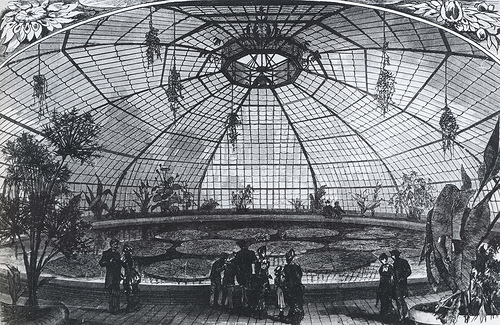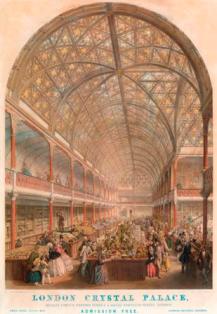 Loading... Please wait...
Loading... Please wait...All prices are in All prices are in AUD
Categories
- Home
- Blog History Revisited
- Sir Joseph Paxton
Blog History Revisited - Sir Joseph Paxton
Sir Joseph Paxton Horticulturalist, Botanist, Architect and Engineer
Posted by ©Sandra Ker Owner and CEO of the Antiquarian Print Gallery 1989-2014 Unley Rd , SA, South Australia. Dealer in Antique Prints and Maps. on 27th Aug 2015
Joseph Paxton (1803-1865)

Joseph was born the seventh son of a Bedfordshire yeoman farmer. He became a garden boy at the age of fifteen for Sir Gregory Osborne Page-Turner at Battlesden Park in nearby Woburn. By nineteen he had created the surrounding parkland and lake. After several moves, he obtained a position in 1823 at the esteemed Horticultural Society's Chiswick Gardens . The 6th Duke of Devonshire frequently met the young gardener as he strolled in the Chiswick Gardens. Out of the blue the Duke offered the 20-year-old Paxton a position at his Chatsworth Estate, considered one of the finest landscaped gardens of the era. With no formal education, his skill and enthusiasm were rewarded by promotion at the age of 23 to Head Gardener. Although considered a landscape gardener, Paxton’s diverse talents gained him a reputation as both architect and engineer, particularly for his design of glasshouses. But more on that later...
Paxton's Magazine of Botany and Flowering Plants.
Paxton was a hugely talented man. With the Duke's support he embarked on The Horticultural Register (1831–5) followed by the Victorian masterpiece, the 16 Volume Paxton's Magazine of Botany and Flowering Plants. The mix of Hand coloured lithographs and engravings by Frederick W. Smith and S. Holden were highly covetted by Victorian horticulturalists. One of the most popular and successful Victorian botanical periodicals.The fine hand-colored engravings and lithographs from Paxton's Magazine of Botany and Register of Flowering Plants claim their honored place as highlights of Victorian botanical illustration. As the nineteenth century ushered in a profound era of plant hunting and gathering worldwide, newly discovered botanical specimens were brought to Europe for cultivation. Sir Joseph Paxton endeavored to include these fine discoveries as part of his horticultural monthly, which also featured the favored British cultivars.
Paxton the Architect & Engineer : Victoria Regis Conservatory
 The structural advances in the lily-house at Chatsworth House served as a model for his design of the Crystal Palace for the London Exhibition of 1851, the first in a series of World Fairs that celebrated the respective country's advances during the Industral Revoluton. The Lily House was the home for the magnificent Victoria amazonia and its construction revolutionised archtectural design.Crystal Palace in Hyde Park, London, the building that would house the "Great Exhibition of the Works of All Nations" in 1851. Over 233 designs were submitted for the building. Paxton produced his design on a piece of blotting paper and submitted the final design in less than nine days. The building itself was erected in just six months, with 293,655 panes of glass, 330 huge iron columns and 24 miles of gutters.
The structural advances in the lily-house at Chatsworth House served as a model for his design of the Crystal Palace for the London Exhibition of 1851, the first in a series of World Fairs that celebrated the respective country's advances during the Industral Revoluton. The Lily House was the home for the magnificent Victoria amazonia and its construction revolutionised archtectural design.Crystal Palace in Hyde Park, London, the building that would house the "Great Exhibition of the Works of All Nations" in 1851. Over 233 designs were submitted for the building. Paxton produced his design on a piece of blotting paper and submitted the final design in less than nine days. The building itself was erected in just six months, with 293,655 panes of glass, 330 huge iron columns and 24 miles of gutters.
London's Great Exhibition's Crystal Palace
 The constituent parts were manufactured in the British midlands and transported to Hyde Park by the crowning glory of the Industrial Revolution, the Railway system. The sheets of glass were the largest made until that construction. Two important conditions were that, as Structure was to be built in a Royal Park, no trees were to be removed or foundations laid. This monumental greenhouse was the perfect solution: it was designed so that all its constituent parts could be prefabricated, erected, and dismantled on site, it only took just over six months to build. If his horticultural contributions were'nt enough, this first large-scale industrial building earned Paxton his knighthood in 1851. In 1854 the building was moved to Sydenham where, until it was damaged by fire in 1936,it housed a museum of sculpture, pictures, and architecture and was used for concerts. In 1941 its demolition was completed because it served as a guide to enemy planes. The building was constructed of iron, glass, and laminated wood. One of the most significant examples of 19th-century, proto-modern architecture, it was widely imitated in Europe and America.
The constituent parts were manufactured in the British midlands and transported to Hyde Park by the crowning glory of the Industrial Revolution, the Railway system. The sheets of glass were the largest made until that construction. Two important conditions were that, as Structure was to be built in a Royal Park, no trees were to be removed or foundations laid. This monumental greenhouse was the perfect solution: it was designed so that all its constituent parts could be prefabricated, erected, and dismantled on site, it only took just over six months to build. If his horticultural contributions were'nt enough, this first large-scale industrial building earned Paxton his knighthood in 1851. In 1854 the building was moved to Sydenham where, until it was damaged by fire in 1936,it housed a museum of sculpture, pictures, and architecture and was used for concerts. In 1941 its demolition was completed because it served as a guide to enemy planes. The building was constructed of iron, glass, and laminated wood. One of the most significant examples of 19th-century, proto-modern architecture, it was widely imitated in Europe and America.
© Sandra Ker www.historyrevisited.com.au
Recent Posts
- » Lady Sarah Lennox, King George III & The Honourable George Napier
- » Schomburgk's Botanic Garden & Park Plan, 1874
- » "City of Adelaide" Clipper Ship - What is Old Is New Again
- » Napoleon, Hudibrastic Poetry, Doctor Syntax & the Power of Satire
- » Colonial Melbourne to Albury "Parlour Car" Photo Connects to Adelaide Past & Present






